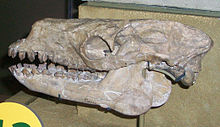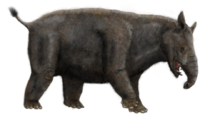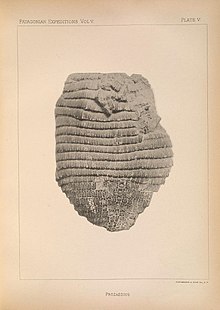| This article relies excessively on references to primary sources. Please improve this article by adding secondary or tertiary sources. Find sources: "Cerro Bandera Formation" – news · newspapers · books · scholar · JSTOR (August 2024) (Learn how and when to remove this message) |
| Cerro Bandera Formation | |
|---|---|
| Stratigraphic range: Aquitanian-Burdigalian (Colhuehuapian) ~21.0–17.5 Ma PreꞒ Ꞓ O S D C P T J K Pg N ↓ | |
| Underlies | Collón Curá Formation |
| Overlies | Neuquén Group |
| Lithology | |
| Primary | Sandstone, mudstone |
| Other | Limestone |
| Location | |
| Region | Neuquén Province |
| Country | |
| Extent | Neuquén Basin |
| Type section | |
| Named by | Leanza and Hugo |
| Year defined | 1997 |
 | |
The Cerro Bandera Formation is a geological formation in Neuquén Province, Argentina, in northern Patagonia, which dates to the Early Miocene, around 21 to 17.5 million years ago. It predominantly consists of pyroclastic deposits, which were deposited in a semi-arid environment. It is divided up into a number of members. The diverse fauna of the Cerro Bandera Formation include a variety of turtles and birds, also includes many mammals such as South American native ungulates (notoungulates, litopterns, astrapotheres) as well as armadillos, and caviomorph rodents.
The Cerro Bandera Formation comprises a series of isolated outcrops that represent the relicts of an old alluvial filling developed on small local valleys. It is composed of a succession of reworked pyroclastic deposits alternating with primary pyroclastic and scant sandstone levels. These deposits were originally recognized at the northeast of Barda Negra, south of Cerro Bandera and northwest of Sierra del Portezuelo; new exposures are herein recognised to the northwestern slope of Cerro Bayo Mesa, Neuquén Province, Argentina. The recovered fossil remains correspond to birds of the family Falconidae and 17 families of mammals, among which are remarkable Cramauchenia, Proadinotherium, Eosteiromys, and Caviocricetus, plus a species of Protypotherium with more primitive dentition than those known from the Santacrucian SALMA. This association confirms a Colhuehuapian SALMA (Early Miocene) for this unit. This fauna is markedly different from that recorded from the lower section of the Chichinales Formation, Río Negro Province. The degree of faunistic differentiation between these probably synchronous units could be a result of local palaeoenvironmental differences.
The fossiliferous localities of the Cerro Bandera Formation are latitudinally equivalent to that of the Chichinales Formation. However, there are marked differences between their known faunal compositions. The only genera shared by both units are Cladosictis, Cramauchenia, Proeutatus, Protypotherium, and Stenotatus. To this must be added the recent discovery of remains of Eoviscaccia in the Chichinales Formation. In this unit the remains of turtles, hegetotheriid and leontiniid notoungulates are extremely abundant; while that in the Cerro Bandera Formation there are still no known remains of turtles, the interatheriids predominate over the hegetotheriids and the large herbivorous ungulates are mostly represented by the astrapotheres. In addition, the presence of at least two new genera only known from the Cerro Bandera Formation belonging to the families Astrapotheriidae and Cephalomyidae, infers a certain degree of faunal differentiation with respect not only to the Chichinales Formation, but also to the typical Colhuehuapian localities of the central Patagonia.
Stratigraphy
The Cerro Bandera Formation occurs as a succession of small isolated whitish to yellowish-brown outcrops, aligned along ancient depressions and paleo-valleys carved in Late Cretaceous and Paleocene sediments. In the study area, the deposits of this unit overlie in erosive discordance several units of the Neuquén Group, including the Huincul, Cerro Lisandro and Portezuelo Formations, from the Late Cretaceous, as well as over Danian marine sediments of the Roca Formation in the Malargüe Group.
The known fossiliferous deposits in the Cerro Bandera Formation consist of isolated concentrations of fossil remains partially exposed on the surface due to the effect of rainwater and wind action. In general, fossil remains tend to be found in greater abundance in those sectors where the sequence is less altered. Possibly, the same factors that contributed to the alteration and devitrification of the pyroclastites also influenced the degradation of the bone materials. In this sense, the dental pieces seem to be the most resistant, having been found in some cases parts of dental series in correct position within the sediment, although any bone remains were completely missing.
At the type locality of the Cerro Bandera Formation, the succession consists of dominantly chonitic (consolidated pyroclastic deposits of very fine grain size, less than 0.062 mm,) and tuffitic deposits. In this outcrop were found two fossiliferous horizons within were found within deposits corresponding to strongly pedoturbed tuffaceous chonites (paleosols). The lower fossiliferous horizon corresponds to the basal deposits of this unit, where remains of small vertebrates were found together with freshwater gastropods.
On the northeastern slope of Barda Negra, the Cerro Bandera Formation exhibits a granocreccive sequence, with predominantly bentonitic (lacustrine) deposits at the base, gradually grading towards the top to deposits with higher epiclastic content (tuffites with sandy lenses), where fluvial sandstones with conglomeratic lenses bearing silicified logs dominate. In this locality, the basal bentonite deposits are commercially exploited in several mining properties, from where some dental and bone remains have been extracted, together with inadequately preserved fossil logs.
In the locality of Sierra del Portezuelo Norte, the unit is formed by an alternation of tuffites, bentonite chonites and tuffaceous chonites. At least four fossiliferous horizons have been recognized at the same locality, of which only the third horizon, located approximately 21 m from the base of the profile, has contributed fossiliferous material significant enough for this analysis. This horizon is located in pedoturbed deposits of tuffaceous chonites, which contributed numerous mammal remains along with scarce, poorly preserved beetle nests.
Finally, a fourth fossiliferous locality has been found on the northwestern slope of Cerro Bayo Mesa, a site where the Cerro Bandera Formation had not been previously recognized. This unit occurs there as a dominantly chonitic and tuffitic succession of thin thickness, with a single fossiliferous horizon, located ca. 13 m from the base of the profile, in levels of pedogenized tuffaceous chonites.
Paleofauna
Reptiles
Testudines
| Name | Species | Material | Notes | Image |
|---|---|---|---|---|
| Testudines indet. | Currently undescribed |
Birds
| Name | Species | Member | Material | Notes | Image |
|---|---|---|---|---|---|
| Falconidae indet. | Currently undescribed |
Mammals
Meridiungulates
| Name | Species | Material | Notes | Image |
|---|---|---|---|---|
| Astrapothericulus | A. sp. | An astrapotheriid | ||
| Comahuetherium | C. coccaorum | An astrapotheriid | ||
| Cramauchenia | C. normalis | A cramaucheniine macraucheniid |  | |
| Hegetotheriopsis | H. sulcatus | A hegetotheriid notoungulate | ||
| Hegetotherium | H. sp. | A hegetotheriid notoungulate |  | |
| Parastrapotherium | P. sp. | An astrapotheriid |  | |
| Proadinotherium | P. cf. muensteri | A toxodontid notoungulate |  | |
| Protypotherium | P. sinclairi | An interatheriid notoungulate |  |
Xenarthrans
| Name | Species | Material | Notes | Image |
|---|---|---|---|---|
| Astegotheriini indet. | Currently undescribed | |||
| Glyptodontinae indet. | Currently undescribed | |||
| Proeutatus | P. sp. | A chlamyphorid armadillo |  | |
| Prozaedyus | P. sp. |  | ||
| Stenotatus | S. sp. |  |
Rodents
| Name | Species | Material | Notes | Image | |
|---|---|---|---|---|---|
| Banderomys | B. leanzai | A cephalomyid | |||
| Caviocricetus | C. lucasi | ||||
| Doryperimys | D. olsacheri | A neoepiblemid rodent | |||
| Garridomys | C. curunuquem | A chinchilloid caviomorph rodent | |||
| Eoviscaccia | E. australis | A chinchillid rodent | |||
| Leucockephalos | L. maior | An octodontoid rodent | |||
| Octodontoidea indet. | Currently undescribed | ||||
| Perimys | P. sp. | A neoepiblemid rodent |  |
Metatherians
| Name | Species | Material | Notes | Image |
|---|---|---|---|---|
| Abderites | A. sp. | An abderitid paucituberculatan | ||
| Borhyaenidae indet. | Currently undescribed | |||
| Cladosictis | C. sp. | A hathliacynid sparassodont |  | |
| Hathliacynidae indet. | Currently undescribed | |||
| Palaeothentes | P. sp. | A palaeothentid paucituberculatan |  | |
| Pitheculites | P. sp. | An abderitid paucituberculatan | ||
| Sipalocyon | S. sp. | A hathliacynid sparassodont |
References
- ^ Kramarz, Alejandro; Garrido, Alberto; Forasiepi, Analía; Bond, Mariano; Tambussi, Claudia (2005). "Stratigraphy and vertebrates (Aves and Mammalia) from the Cerro Bandera Formation, Early Miocene of Neuquén Province, Argentina". Revista Geológica de Chile. 32 (2). doi:10.4067/S0716-02082005000200006.
 Material was copied from this source, which is available under a Creative Commons Attribution 3.0 International License
Material was copied from this source, which is available under a Creative Commons Attribution 3.0 International License
- Barrio, Claudio; Carlini, Alfredo A.; Goin, Francisco J. (1989). "Litogénesis y antigüedad de la Formación Chichinales de Paso Córdoba (Río Negro, Argentina)". Actas, IV Congreso Argentino de Paleontología y Bioestratigrafía, Mendoza. 4: 149–156.
- Leanza, Héctor A.; Hugo, Carlos A.; Herrero, Juan Carlos; Donnari, Eva I.; Pucci, Juan Carlos (1997). "Hoja Geológica 3969-III Picún Leufú". ISSN 0328-2333.
{{cite journal}}: Cite journal requires|journal=(help) - Alejandro Kramarz and Mariano Bond (2011). "A new early Miocene astrapotheriid (Mammalia, Astrapotheria) from Northern Patagonia, Argentina". Neues Jahrbuch für Geologie und Paläontologie - Abhandlungen. 260 (3): 277–287. doi:10.1127/0077-7749/2011/0132. hdl:11336/68995.
- ^ Kramarz, Alejandro Gustavo; Paz, Ernesto Rodrigo (2013). "Un Hegetotheriidae (Mammalia, Notoungulata) basal del Mioceno temprano de Patagonia". Revista Mexicana de Ciencias Geológicas (in Spanish). 30 (1): 186–195. ISSN 1026-8774.
- ^ Kramarz, Alejandro G.; Bond, Mariano; Arnal, Michelle (2015). "Systematic Description of Three New Mammals (Notoungulata and Rodentia) from the Early Miocene Cerro Bandera Formation, Northern Patagonia, Argentina" (PDF). Ameghiniana. 52 (6): 585–597. doi:10.5710/AMGH.27.06.2015.2906. ISSN 0002-7014.
- Kramarz, Alejandro Gustavo (2005). "A primitive cephalomyid hystricognath rodent from the early Miocene of northern Patagonia, Argentina". Acta Palaeontologica Polonica. 50 (2): 249–258.
- Kramarz, Alejandro G.; Vucetich, María G.; Arnal, Michelle (2013-09-01). "A New Early Miocene Chinchilloid Hystricognath Rodent; an Approach to the Understanding of the Early Chinchillid Dental Evolution". Journal of Mammalian Evolution. 20 (3): 249–261. doi:10.1007/s10914-012-9215-0. hdl:11336/8425. ISSN 1573-7055. S2CID 15857003.
- Cerro Bandera Formation
- Geologic formations of Argentina
- Colhuehuapian
- Burdigalian
- Aquitanian (stage)
- Miocene Series of South America
- Neogene Argentina
- Tuff formations
- Sandstone formations
- Fluvial deposits
- Lacustrine deposits
- Deltaic deposits
- Fossiliferous stratigraphic units of South America
- Paleontology in Argentina
- Neuquén Basin
- Geology of Neuquén Province
- Geology of Patagonia